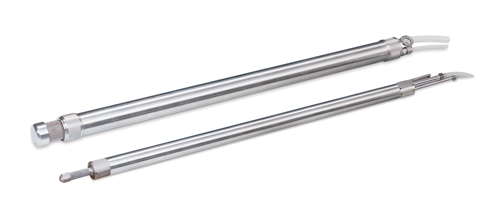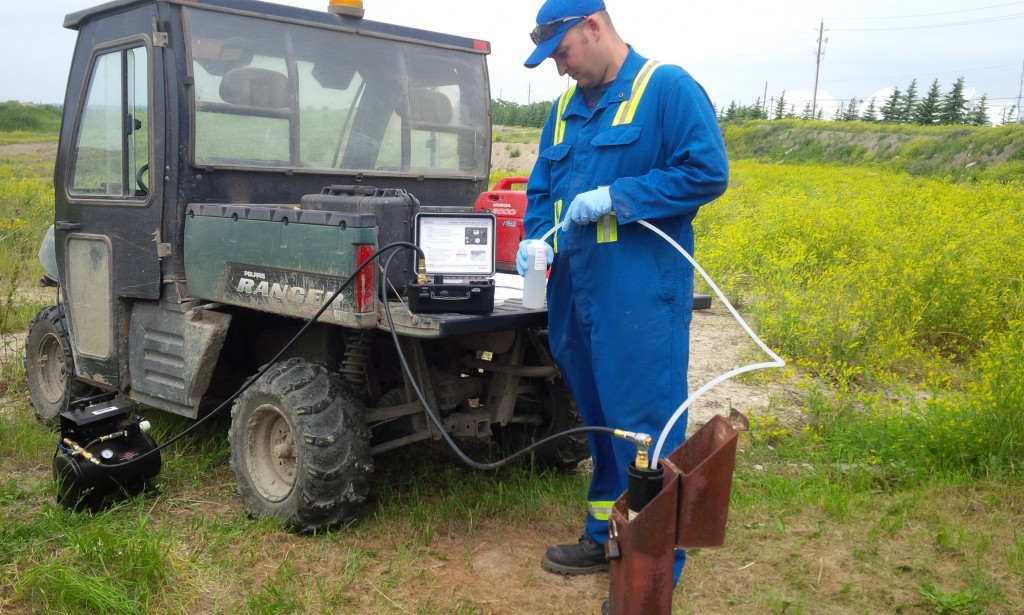An environmental monitoring program is an essential part of any successful landfill operation. Monitoring ensures that a landfill is functioning as it should, and that wastes do not migrate off-site or pose potential risks to nearby receptors. Regular environmental reporting ensures that operators comply with the regulations and approvals that govern them.
Landfill Technicians Brad Mullin and Rob Schwartz head the environmental monitoring program at the Newalta Stoney Creek Landfill in Ontario, Canada. With over 21 and 8 years experience, respectively, working for Newalta, they are involved in every aspect of the environmental sampling program at the 59-hectare landfill site. The landfill accepts non-hazardous solid wastes from industrial, commercial, and institutional sources, and has been in operation for approximately 18 years.
Regular groundwater sampling is a part of their environmental monitoring program. There are over 170 monitoring wells at the landfill, which are sampled quarterly. In order to keep up with their reporting requirements, a solution was required for some “hard-to-sample” wells. A number of options were looked at, but in the end, they decided to try Solinst Model 407 Bladder Pumps.

Solinst Model 407 Bladder Pumps – 1″ and 1.66″ Diameter Stainless Steel
The Model 407 Bladder Pumps appealed to them, as they provide an option for low flow sampling – which they noted is a sampling protocol more commonly accepted by regulators, including the Ontario Ministry of the Environment. They are also familiar with Solinst products, having worked with different Solinst instruments in the past.
What is low flow sampling? Low flow sampling involves extracting groundwater at rates comparable to ambient groundwater flow (typically less than 500 ml/min), so that the drawdown of the water level is minimized, and the mixing of stagnant water with water from the screened intake area in a well is reduced, overall, providing a representative sample.
Initially, there was hesitation to try instrumentation that was new to them, but after visiting Solinst for hands-on training, Brad and Rob have become very comfortable with the equipment. Randy Blackburn, Product Manager with Solinst, demonstrated how to set-up and install the pumps, tubing, and wellhead, as well as how to operate the Solinst Model 464 Pump Control Unit. They were also shown how to simply calculate the amount of pressure and the drive/vent cycles required to retrieve a sample from a specific depth, at the ideal flow rate.
How does a Bladder Pump work? When a Bladder Pump is placed in well, water rises inside the bladder and sample tubing to static level. Compressed nitrogen or air is supplied to the pump via the drive tubing using a Control Unit. Pressure causes the bladder to compress and closes the bottom check valve, forcing water from the bladder into the sample tubing. During a vent cycle the pressure is released. The bladder returns to its initial state as water refills the pump, while the top check valve prevents water in the sample tubing from falling back into the bladder. Cycling the drive and vent provides water flow.
They are very impressed with the service and quick turn-around of information and product that they were provided. In all, six 1.66″ diameter stainless steel Model 407 Bladder Pumps were purchased, along with dedicated wellheads for permanent installation of the pumps. A portable Model 464 Pump Control Unit and Solinst 12V Compressor were also purchased to operate the pumps.
The Bladder Pumps were installed in the field quickly and easily. They were able to install all six pumps themselves, with ease. Using a setup of spools, they lowered the drive and sample tubing, and the pump using a Kevlar support line, all at once to the desired depth. On average, the pumps are installed to a depth of 18 m.
Given that this site experiences cold weather and receives substantial snow, Brad made the choice to include a freeze protection option with the Solinst well caps.
A team of technicians at the landfill performed the installations and the initial sampling rounds, but since, they have found that one technician can just as easily do the pumping on their own. This has become a major advantage of the Bladder Pump setups.
The results of the first round of sampling, as part of their reporting requirements, came this July. Brad noted “the pumping was done without any hick-ups, resulting in good samples obtained by the Bladder Pumps. The lab that processed the samples are also pleased with the samples provided to them.”
“From installation to sampling, we are extremely happy with the Bladder Pumps,” says Brad, “the entire process has gone very smoothly, without issues.” With a section of the Stoney Creek Landfill being redeveloped as parkland, Brad and Rob are looking to add Solinst Bladder Pumps to more of their monitoring wells, especially to monitor in this critical location.
Solinst thanks Brad Mullin and Rob Schwartz of Newalta, for providing the details of their experience with Solinst Bladder Pumps.

